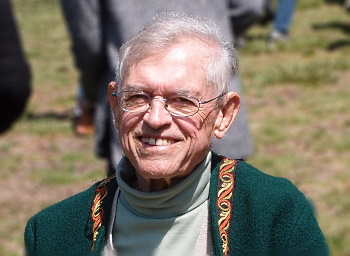
Dave also served as president of the American Society of Naturalists and the Society for the Study of Evolution (also serving as Editor for Evolution). He was elected to the American Philosophical Society, the American Academy of Arts and Sciences, and the National Academy of Sciences. As a long-serving handling editor/reviewer for PNAS he was involved in a seismic shift in the standards, diversity, accessibility, and content of the journal.
For his first 17 years Dave lived in Pierpont, South Dakota, but longed to leave. Dave’s interest in biology emerged from growing up in an agricultural community and with conversations with farmers at his father’s hardware store. His maternal grandfather (Henrik Martinus Solem) cultivated his intellectual curiosity and promoted a love of natural history and evolution. Dave’s family moved to Tacoma, Washington in 1953. He graduated from Pacific Lutheran University in Biology in 1958, and became captivated by salamanders. Dave attended graduate school at the University of Southern California, where he worked on plethodontid salamander skeletons. Amphibians, and in particular salamanders, were to be Dave’s focus from then on. It was while in the lab of Jay Savage that he met Marvalee Hendricks in 1959, whom he married in 1962. David and Marvalee, both together and each in their own right, built a supportive community for their vibrant labs, contributed to the growth of scientific societies, and the MVZ and biology at UC Berkeley, and fostered each otherʻs intellectual growth during joint sabbaticals which often led to new directions that were highly influential to evolutionary biology.
David Wake’s career has been the antithesis of the ‘Krogh Principle’: that for any question there is an ideal study animal for providing the answer. The Wake principle would be that major questions can be answered by a careful enough examination of salamanders. Across more than 430 papers, books, and edited volumes, he demonstrated that salamanders can lead to new understanding in biology. Ontogenetic trajectories, heterochrony, and a new framework for thinking about timing across development? Salamanders, with and without gills are a useful example. Need a geographically constrained analog for latitudinal gradients? Consider salamanders distributed along an altitudinal gradient in the neotropics. If you must be very, very small, what do you leave out and how do you get there? Well, look to Thorius and other miniaturized salamanders. Running low on salamanders to talk about? Dave and his colleagues described over 100 species, fully 15% of all salamander diversity. Salamander diversity in form, physiology, and function inspired him to organize our thoughts on homoplasy and homology. The underpinnings of some of the most evocative ideas about evolutionary change are rooted in salamanders. He was fearless in adopting new technology, using computational methods in analyzing phylogeny as early as 1969, and building a joint molecular lab for collaboration across the MVZ that produced many publications and launched careers. To understand the current and historical status of his favorite vertebrates he pioneered the use of the Internet as a portal to all museum data on ranges and dates for collections, allowing for new grand syntheses. AmphibiaWeb and HerpNET are how we really understand the threats to global herpetological diversity and are a model for tracking other groups of organisms.
He lived his life valuing each person, regardless of gender, race, or background. He always supported the careers of women, even at a time when there were very few in science. Many successful female herpetologists and evolutionary biologists got their start as integral parts of his lab from the early days. He and Marvalee delighted in babies born in the MVZ community, ensuring that their professional moms felt welcome and honored. He was a large part of the welcome that students and staff felt at coffee hours, the famed MVZ Herp group, and the regular social events that formed part of the fabric of the community. Despite his giant professional stature, he was ever humble and demonstrated a deep value for people throughout his life. His students remember him as unfailingly kind, devoted to building community, and concerned with their individual success. As a teacher, he influenced leagues of UC students through his legendary Evolution course, which inspired many young scientists directly and influenced the teaching of evolution across numerous universities as his former students modeled their own courses using his wonderful notes.
Professor Marguerite A. Butler; Professor Frank E. Fish; Professor Adam P. Summers

